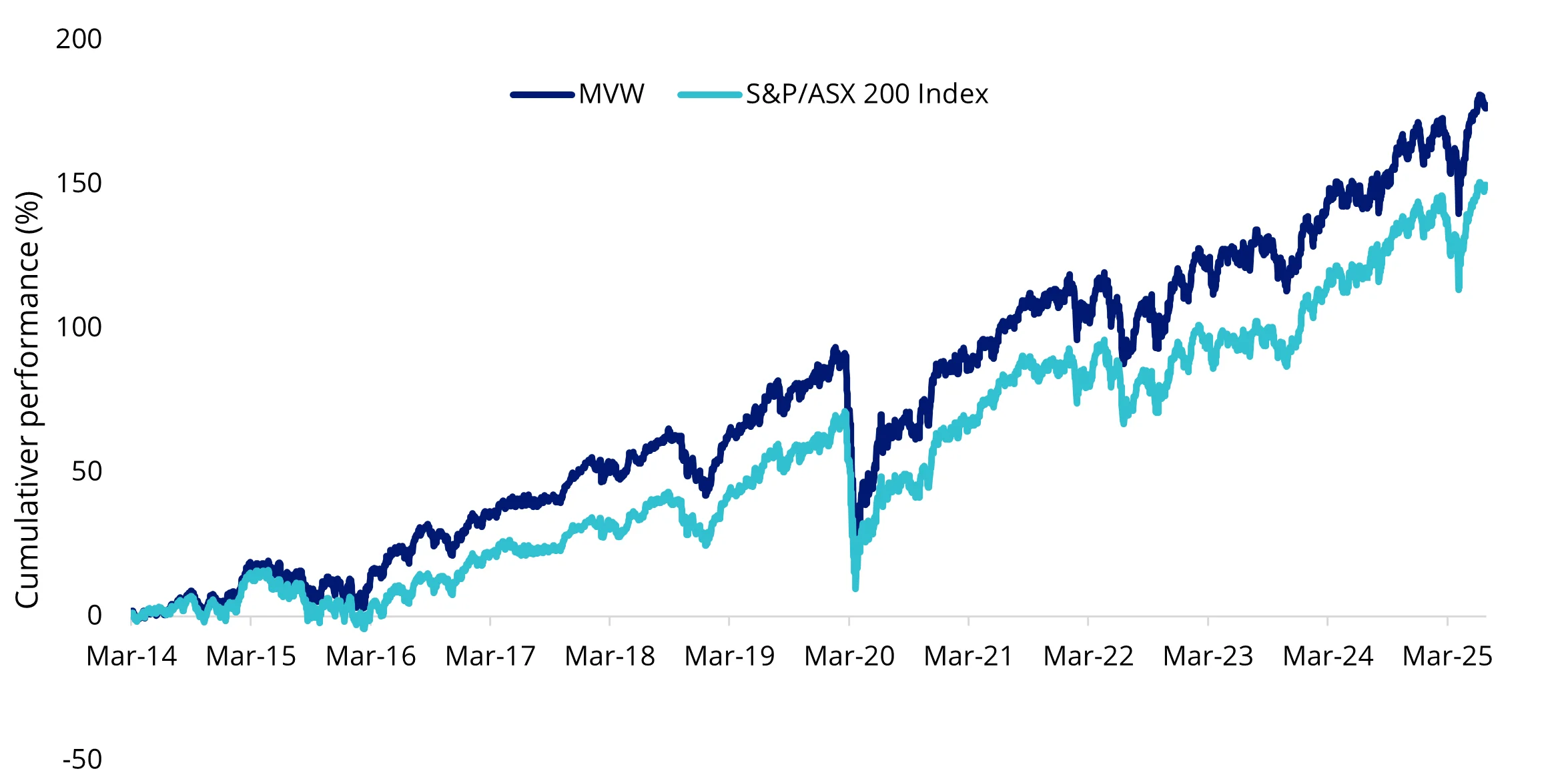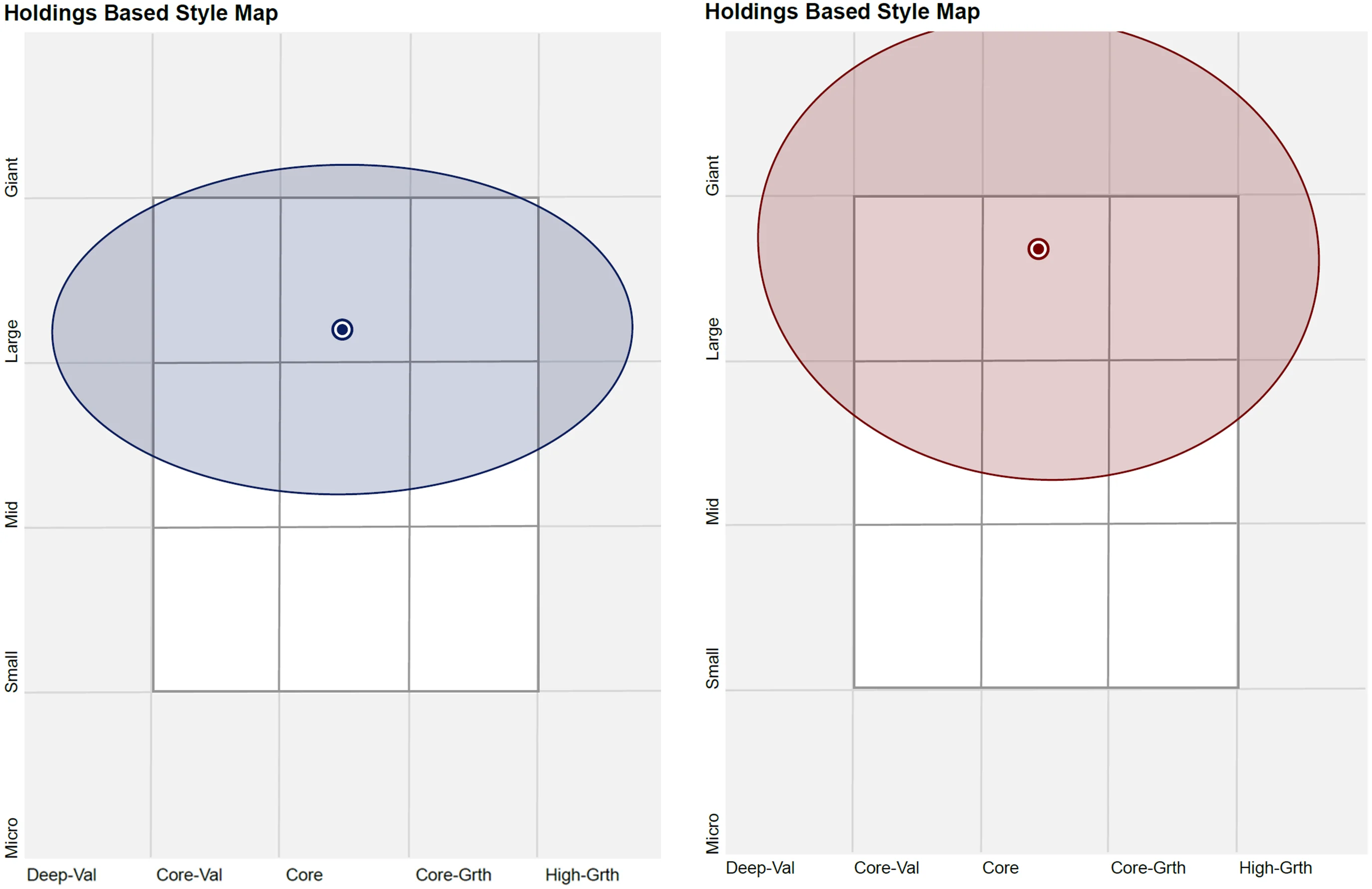Analysis: MVW
The Australian equity market had a strong 2024/25 financial year. While many in the media have been publicising the local market’s return in the lead up to, and after 30 June, there were a couple of prices that caught our eye.
Is this a simple way to beat the ASX 200? and Advisers favour benefits from equal weighted ETFs
Both of these are about equal weight investing. Equal weighting is a portfolio construction methodology that weights each of its constituents in the same proportion. It is a simple approach that is easy to understand. It is also an approach that has the backing from empirical research1.
An equal weighted index is different from indices like the S&P/ASX 200 or NASDAQ 100. These are what are called ‘market capitalisation’ indices. A company’s representation in a market capitalisation index is in proportion to its size; the bigger the company, the larger its representation in the index. Most of the indices quoted in the media, such as the S&P 500 and FTSE 100 are market capitalisation indices. These indices were designed to be barometers of the market’s health and were not designed to be the basis of an investment. However, as investing evolved, passive fund managers started to track these indices, giving their investors benchmark-like returns.
Not everyone is happy with benchmark-like returns. Active fund managers try to outperform market capitalisation benchmarks. They think they can outperform these benchmarks because of some of the shortcomings of these benchmarks. This includes:
- Weighting a fund according to market capitalisation can have a negative impact on performance. This is because when the market overvalues a stock, its market capitalisation goes up. A fund tracking a traditional market capitalisation index buys more and more of the overpriced stock and loses money when the market corrects. Conversely, when the market undervalues a stock, the fund sells more and more of the underpriced stock, missing profit when the market corrects.
- An investor seeking to maximise returns wants to allocate more to those companies with the greatest growth potential. By allocating to a market capitalisation index, the assumption investors are making is that those companies with the greatest growth potential are the largest, because they get more of the investment. This issue is more problematic in concentrated markets. The S&P/ASX 200 exposes investors to excessive concentration risk. The top 10 companies represent nearly 50% of the index. Three of the top six companies are banks. CBA is now 12% of the index. CBA’s 2024/25 performance and its impact on Australian markets has featured in the AFR (Retail investors are laughing all the way to the (Commonwealth) bank and Investors await CBA correction to kickstart mining resurgence).
Perhaps an equal weight index warrants consideration for a broad Australian equity approach.
An equal-weight index, like the one tracked by VanEck Australian Equal Weight ETF, MVW, allocates exposure away from mega-cap stocks. MVW has greater exposure to companies outside the top 10, and is more diversified than the market capitalisation index.
Since its launch, MVW has outperformed the S&P/ASX 200.
Let’s walk through the difference between MVW and the S&P/ASX 200, and we will start with performance, noting that this is not indicative of future performance.
MVW vs S&P/ASX 200 - Performance
Equal weight investing has served Australian investors well. Since its inception on ASX in 2014, MVW has outperformed the S&P/ASX 200 by 1% p.a. What this also means is that over that time MVW has outperformed ETFs tracking that index.
Chart 1: Cumulative performance since MVW inception date to 30 June 2025

Table 1: Trailing performance to 30 June 2025

* MVW Inception date is 4 March 2014 a copy of the factsheet is here.
Chart 1 and Table 1 source: Morningstar Direct, VanEck. The chart and table above show past performance of MVW and of the S&P/ASX 200. You cannot invest directly in an index. Results are calculated to the last business day of the month and assume immediate reinvestment of distributions. MVW results are net of management fees and other costs incurred in the fund, but before brokerage fees and bid/ask spreads incurred when investors buy/sell on the ASX. Returns for periods longer than one year are annualised. Past performance is not a reliable indicator of future performance. The S&P/ASX 200 Index is shown for comparison purposes as it is the widely recognised benchmark used to measure the performance of the broad Australian equities market. It includes the 200 largest ASX-listed companies, weighted by market capitalisation. MVW’s index measures the performance of the largest and most liquid ASX-listed companies, weighted equally at rebalance. MVW’s index has fewer companies and different industry allocations than the S&P/ASX 200. Click here for more details.
MVW vs S&P/ASX 200 Index - Top 10 holdings
Below you can see the top 10 companies. The differences are stark – to see all the holdings in MVW and their weightings, click here. In the S&P/ASX 200 48.25% of the portfolio is represented by the top 10. In other words, 190 other companies are squeezed into the remaining 51.75% of the portfolio.
Table 2 & 3: Top 10 holdings MVW and S&P/ASX 200
Source: FactSet, VanEck, MVIS, as at 30 June 2025.
The reason MVW’s holdings are not equal above is that it only rebalances back to equal weight each quarter.
MVW vs S&P/ASX 200 Index - Sectors
MVW is currently underweight the financials’ sector by 14.4% compared to the S&P/ASX 200 and underweight materials (-3.0%). Conversely, it is overweight industrials by 8.7%, real estate by 2.9% and utilities by 2.6%.
Chart 2: MVW and S&P/ASX 200 sector weightings

Source: FactSet, 30 June 2025
What this means is that if there is another systemic banking issue, or pressure on commodities, the impact on the S&P/ASX 200 is greater than on MVW.
MVW vs S&P/ASX 200 - Diversification
A way to measure diversification of a portfolio is to calculate its Herfindahl Index. This index is a broadly used technique to quantify concentration. When used inversely, this index measures diversification. As at the last rebalance in March 2025, the Herfindahl Index for the S&P/ASX 200 was 334. The equivalent measure for the index MVW tracks was 135. The S&P/ASX 200 Index is therefore around a two and half times as concentrated as the S&P/ASX 200. In other words, the MVW Index is almost 2 and a half more diversified than the S&P/ASX 200.
MVW vs S&P/ASX 200 Index - Style
When looking at portfolios it is important to determine what style e.g. value or growth and what size bias a portfolio holds e.g. giant, large, mid or small. Below we can see MVW’s. Importantly MVW holds large companies with a similar value-core orientation relative to the S&P/ASX 200, which skews larger (giant). Importantly, MVW’s holdings are still large, liquid companies.
Chart 3 & 4: MVW holdings and S&P/ASX 200 holdings based style map

Source: Morningstar Direct, as at 30 June 2025.
While each Australian equity ETF has its merits for portfolio inclusion, you should assess all the risks and consider your investment objectives.
Past performance is no guarantee of future performance. The above is not a recommendation. Please speak to your financial adviser or stockbroker.
For further information you can email us or call on us on +61 2 8038 3300.
Key risks
Investment in MVW carries risks associated with: Financial markets generally, individual company management, industry sectors, fund operations and tracking an index. See the VanEck Australian Equal Weight ETF PDS and TMD for more details.
Source:
1A discussion of the academic support of equal weight is in the appendix of this paper: The unequalled power of equal weight investing.
Published: 11 July 2025
Any views expressed are opinions of the author at the time of writing and is not a recommendation to act.
VanEck Investments Limited (ACN 146 596 116 AFSL 416755) (VanEck) is the issuer and responsible entity of all VanEck exchange traded funds (Funds) trading on the ASX. This information is general in nature and not personal advice, it does not take into account any person’s financial objectives, situation or needs. The product disclosure statement (PDS) and the target market determination (TMD) for all Funds are available at vaneck.com.au. You should consider whether or not an investment in any Fund is appropriate for you. Investments in a Fund involve risks associated with financial markets. These risks vary depending on a Fund’s investment objective. Refer to the applicable PDS and TMD for more details on risks. Investment returns and capital are not guaranteed.
MVIS Australia Equal Weight Index (‘MVIS Index’) is the exclusive property of MarketVector Indexes GmbH ('MarketVector')based in Frankfurt, Germany (‘MVIS’). MVIS is a related entity of VanEck. MVIS makes no representation regarding the advisability of investing in the Fund. MVIS has contracted with Solactive AG to maintain and calculate the MVIS Index. Solactive uses its best efforts to ensure that the MVIS Index is calculated correctly. Irrespective of its obligations towards MVIS, Solactive has no obligation to point out errors in the MVIS Index to third parties.




